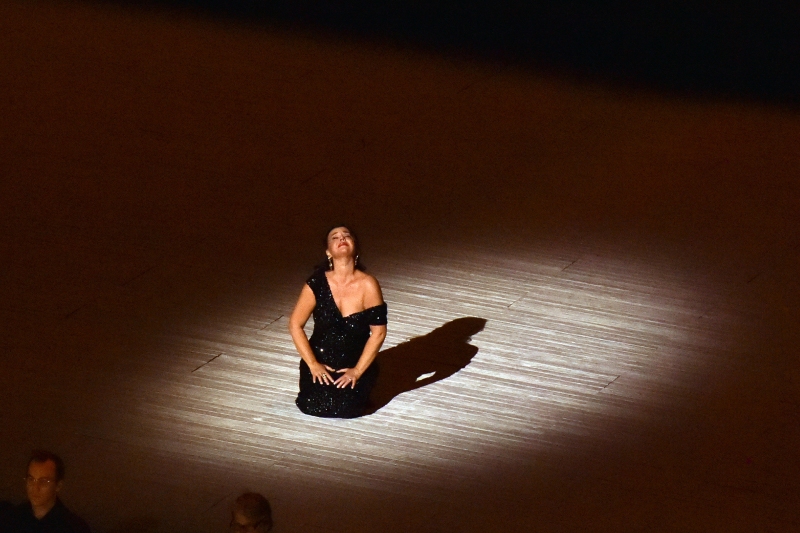
The Chorégies d’Orange closed triumphantly on July 22, with a semi-staged version of Giacomo Puccini ‘s masterpiece Tosca, to which the festival wanted to pay tribute in this centenary year.
The venue was full, especially since the cast assembled in the Provençal city by Jean-Louis Grinda had enough to make lyrical art aficionados from all over Europe run: Aleksandra Kurzak in the title role, Roberto Alagna as Mario and Sir Bryn Terfel as Scarpia, no less.

Each act saw a giant projection on the wall: a portrait of Mary Magdalene in the first act, Titian’s painting Diana and Callisto in the second (the connection is less clear? …), and finally a view of the Castel Sant’Angelo in the last, the superb lighting by Vincent Cussey also contributing to the visual success of the show. But above all, far from being content with delivering their arias and their ensembles in front of the audience, these three stage beasts that are Kurzak, Alagna and Terfel distil “theatre” in each of their interventions, with more force and dramatic truth than in many stage versions…
Polish soprano Aleksandra Kurzak immediately humanizes her character, through her acting talents and her electric presence, cooing or roaring, delicately varying her request or order to her lover: ” But make her eyes brown! ” – which she makes less of a diva’s demand than a little girl’s whim that still inhabits the woman. This is an essential quality of her acting: psychological and vocal nuances while some expect, and we hear too often, histrionic, even hysterical overload… Everything is elegance and modesty in this great lady of singing, with great class, a round and even, fleshy voice, while some piani miraculously pass the formidable ramp of space. Her prayer and THE great emotional moment of the evening, through modesty and restraint: it is the questioning of the horror of what happens, it is incomprehensible to her, something beyond her.
Sheep-like, critics often follow one another and it is now fashionable to be picky about Roberto Alagna : “Alagna does Alagna”, a phrase repeated ad nauseam (thank goodness he doesn’t do someone else…). His high notes are certainly less luminous than a decade ago… but of what tenor can we not say that, as time goes by? And then “doing Alagna”, what is it? A commitment without cheating, a passion that he communicates, a medium that is today fuller on which his solid and always solar voice leans. Of course, he loves certain notes so much that he doesn’t want to let go of them, adding quite useless tremolos… but what presence and he always preserves timbre!
Magnificent stage incarnation of Scarpia by the great Bryn Terfel also, with nuances of perverse tenderness in carnal desire, like the cat playing lovingly with the mouse, before slipping like a feline behind its prey, sniffing it and being sure to hold it in its claws at the moment when Tosca responds favorably to its demands.
A formidable, terrible role, almost bass then baritone, he sings first valiantly with an unleashed orchestra and all of the choirs in the first act; he is lucky that the conductor, at that moment, displays the beautiful fabric of a Nice Philharmonic Orchestra (which we have however known to be in better shape… especially on the cello side…), without stifling the singers. However, with the stormy orchestral growth and a slower tempo, we have an insurmountable barrier to his high notes, reducing this great Wagnerian singer almost to silence. This is also a hinderance for the other singers.

Without forgetting the remarkable combined Choirs of the Opéra Grand Avignon and the Chorégies d’Orange (prepared by Pierre-Louis Bonamy ), we salute the high standard of the rest of the cast, Carlos Natale as Spoletta, while Jean-Vincent Blot lends his great heroic voice to Angelotti. The Nîmes native Marc Barrard plays a weak and vile sacristan, Jean-Marie Delpas plays a good sidekick, while the soprano Galia Bakalov offers a real moment of vocal grace with the Shepherd’s song at the beginning of the third act.

Less than a week after her triumphant direction of the Orchestre National de Montpellier Occitanie (much better sounding than their colleagues from Nice who, to their credit, had to battle against a persistent mistral with gusts that did not spare flying scores…), the young Italian conductor Clelia Cafiero again sparks our enthusiasm. Seeing her conduct is a real pleasure, as her flexible and “calligraphic” direction is a pleasure at all times, especially since this grace is combined with quite incredible strength and mastery, catching with panache the moments of wandering of a visibly destabilized phalanx… but without there being enough to spoil the joy of an audience that certainly did not hide its pleasure in the entire artistic team!
Photos (c) Philippe Gromelle.
VIDEO : Roberto Alagna sings the aria “E lucevan le stelle” from Tosca at the Chorégies d’Orange